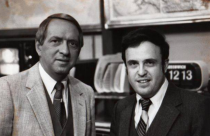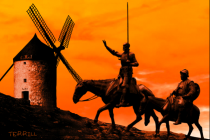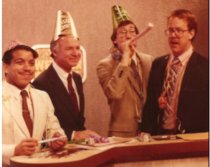The Weather Channel turned 36 years old May 2nd.
In recognition of Independence Day, we have reduced the price to $17.76. Here Art Director Eddie (E.T.) Terrill talks about the book with a spoof of Neil Diamond’s America.
Most everyone has watched The Weather Channel at some time over the years. Have you ever wondered how the channel came about and what it took to become one of the most successful and well-recognized names in cable. The Founders and doers of the early days in ‘Weather Channel Pioneers’, give you a glimpse of these wild early days when it all came together. The updated website describes the adventure with videos and excerpts. It features a spoof video by a Pioneer honoring the Pioneers here and gone. Authors of the book include the late, great John Coleman, a friend, a true visionary and a fellow crusader for good climate science and many of the original staff.
John Coleman first told me about his dream of a 24x 7 cable weather network when I was working as a vacation fill-in weather producer for his weather shows for Good Morning America in the hot summer of 1980. Like a moth to a flame I was drawn to follow him. My family and I left my home in beautiful Vermont to work with John full-time on Good Morning America (GMA) out of the WLS studio in Chicago.

John was a veritable meteorological broadcaster rock star. He worked magic with chromakey green screen technology, pulling weather maps out of the air on WLS and GMA in a world mostly still using magnetic maps. He was winning awards for his on-air weather presentations.
I worked with him, 2 artists and two producers all night starting before midnight to produce 4 shows. As exciting as that was, John was frustrated by the fact the time allotted for each show was never guaranteed. If the news or sports segments ran over, weather took the hit on time.
He was convinced that what was needed was a 24x7 weather network like CNN was doing for news instead of the 15 to 18 minutes of weather/day on the networks and most local channels. We would always be there when they needed weather information - much like what the internet brings today
Over the year, he polished up the business plan and sometimes after his last morning show would fly off to a distant city to try and sell the idea, was rejected or even laughed at, flew home, changed his clothes and came to work. The other days after the last show, we’d go to the office and talk about his weather cable idea. What would we produce and present, how many forecasters and broadcasters and artists would we need, what companies would we team with for data and technology. What doesn’t exist we will need to create to do it right.
After a year of rejections though I was feeling a little like Sancho Panza following Don Quixote on his impossible dream quest.

But suddenly there was interest - Dow Jones then WGN - each time the interest and our excitement spiked then faded but then Landmark Communications entered the picture - with newspapers, radio and TV stations, cable systems, they had wanted to expand into cable programming to do news when the CEO developed cancer. While they waited, Ted Turner launched CNN. After the CEO recovered, they set up new venture groups to explore alternatives. One of the members was in a poker game with John Coleman and when John told him about his weather programming idea. He brought him to Landmark, they quickly worked out a deal and we were off and running.
That’s when it got crazy - we were off to Atlanta in October1981. John and I were very busy defining the product with the artists and producers. I hired two of my students to help me screen candidates for on and off camera positions. Resumes and tapes poured in during December and January. We hired many over the phone. The Pioneers reported for orientation March 1, we started practicing in April and launched May 2, 1982.
At start-up, amazingly we had 58 full-time broadcasters and forecasters with a total of 66 degrees and 450 years of meteorological experience.
We were state of the art for the time, but the technology was changing at a breakneck pace.
It was just the start of the computer graphics revolution in broadcasting and we lead the way with more than half a dozen such graphics systems including the first in the lines of high resolution paint boxes. Our artists, who originally did some graphics or art on paper that was then captured by cameras, quickly transitioned to using pen and palette. All graphics were funneled through a unique frame storage system.
The On Camera Meteorologists would load their shows and control the graphics display from the studio desk. There were no directors.
In parallel our technical staff worked furiously to be able to deliver the local weather, local forecasts and all severe weather NWS messages. We developed computer units that went into every cable system that knew its location and grabbed and displayed its information in formatted pages in the Local Weather and across the bottom of the screen. For it to work, we had to get the NWS to change how they formatted their local forecasts and warnings with address coding that allowed our systems to know what was important to them and where they get displayed.
When the weather was serious and it usually was somewhere in the nation, we were very serious on-air and worked very hard behind the scenes. When it was quiet, we let our hair down a little (it was the 1980s) and had some fun while still communicating information. The network in the early days was described as the first TV reality show, one of its appeals.

It really was an amazing journey that can’t be told in 1000 words, which is why we wrote a book.
In the book, we attempted to capture more of that story, that journey from one man’s vision to a shared vision of a large team of wonderful, courageous and talented individuals that came to Atlanta from all corners of the country in many different disciplines to undertake something special and unprecedented, unique people we call the Weather Channel Pioneers.
During this incredibly dynamic period, everyone went straight out, never entertaining the thought that what we wanted to do was impossible. We pulled off everyday miracles, overcame all obstacles and changed the paradigms for technology, weather data and warning delivery, graphics and on-air weather presentations. It was a time and a team like no other.
In the book, the Pioneers tell that story. It is about the early days not about what has transpired over the years.
http://Weatherchannepioneers.com is the web page that tells you more and links to the Amazon site where you can purchase the book. There are soft copy and e-book versions with over 120 pictures. We dedicated it to john Coleman. We hope if there is any profit, it will help support the reunion of the original Pioneers in 2019 in Atlanta. It may be the last time we will be together to revisit those magical days. We have already lost over a dozen of the originals’. We hope to do a video with the originals revisiting the days leading up to and following the successful launch in a network that set new paradigms for meteorology, presentation, technology for local data, forecast and warning delivery and so much more. It will bring back memories. Tom Skilling, who was a sounding board and helped John market the idea wrote this about the significance of TWC and on “his friend John Coleman’s passing:
“It was in a world which had never seen a weather channel---had no idea what such an entity would even look like---that John Coleman embarked on a mission which would occupy years of his life and end up revolutionizing the way meteorological information was communicated.”
Then Tom after reading the book responded:
Hi Joe,
I just had to write to tell you the book is amazing! What a tribute to John and what an amazing piece of work. As I read through it, all I could think about is about is the work you put into it. It shows! You have produced THE written record of one of the seminal advances in the field of meteorology--the creation of the Weather Channel. Your role in putting a staff for the channel was an achievement in and of itself. There was no model to follow, you broke new ground--and what a job you did.
That you to included me in this effort is an honor beyond words. THANK YOU, Joe ”
Jim Cantore, the face of todays’s TWC echoed Tom:
“Even though I didn’t start my TWC journey until 1986, I had no idea as a young man of 22 years what a wonderful opportunity I had been given to learn about life and meteorology from many of these TWC Pioneers. There are too many to name, but dozens of these men and women had a profound and lasting influence on the broadcaster I am today. What an incredible trip down memory lane revisiting the heart and soul of The Weather Channel as it was being born and as it became one of the most trusted brands in the world. These TWC pioneers didn’t just start a cable TV weather channel, they saved lives and created a mission of service which still resonates with millions of people to this day.”
- Jim Cantore
Memories....from TWC Art Director Eddie Terrill




